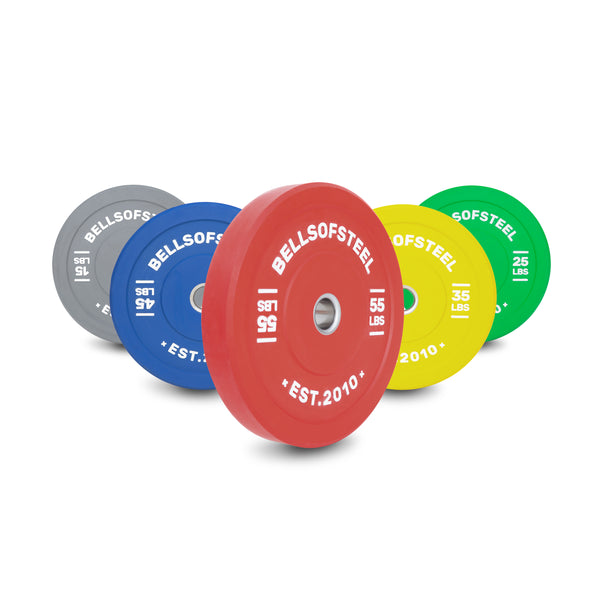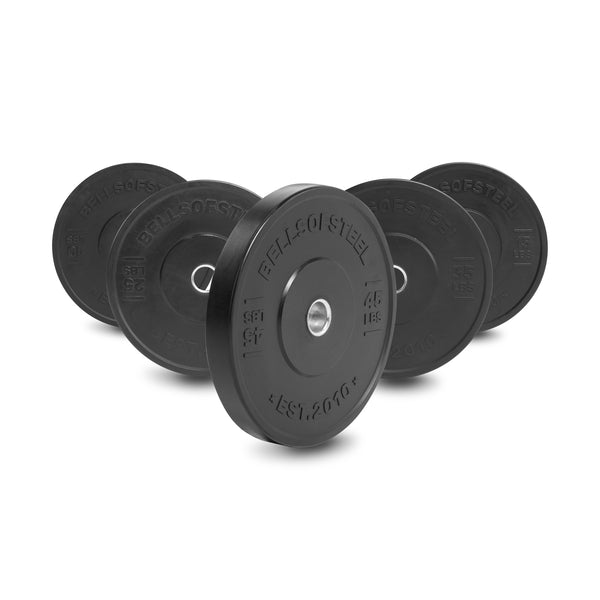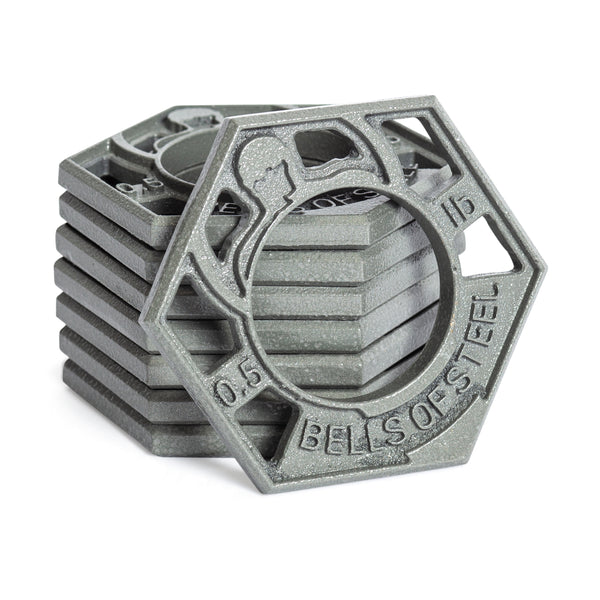There’s an old saying in the weight room: more plates equals more dates. Whether you’re in the iron game for yourself or trying to charm a possible admirer, we’re not one to judge. But which kind of weight plates should you choose to build your dream physique to impress your soon-to-be workout partner: shock-absorbing bumper plates, or old school cast iron?
The truth is, it depends almost entirely on how you like to train and the flooring you’re lifting on. In this article we’ll cover the main differences between bumper plates vs weight plates, to help you decide. Generally, there are three different types of bumper plates:
Let’s dive into each one a bit further.
Crumb bumper plates are the most affordable option. Crumb rubber is recycled rubber from old tires, so it’s one of the more environmentally-friendly options that reuses tires instead of them ending up in the landfill. That said, the crumb rubber usually results in smelly and bouncy bumper plates. Because of this, expect to control the bar somewhat after it’s dropped. Important note: the smell dissipates after a couple weeks.
Virgin bumper plates have noticeably better quality. They’re made with high-density virgin rubber, which means that the rubber is brand-new instead of being made from recycled tires. This leads to less bounce, so your barbell will be much more controlled after being dropped from overhead. Also, they’re much less smelly as a result! Lastly, this tier of bumper plate tends to be decorated nicely. Clear lettering with vibrant colours, or sometimes the entire plate being coloured, is fairly standard — making it a piece of cake to identify them across the room.
Finally, you have the gold standard — competition bumper plates. These are the “crème de la crème”; standardized diameters, colour-coded, locked-in center hubs, and tolerances that are less than 0.1% off the claimed weight, or +/- 15 grams. Although not officially sanctioned for International Weightlifting Federation (IWF) competitions, these plates are great for accurate training. Heads up, not all rubber coated plates are meant to be dropped! There is a distinct difference between bumper plates and rubber coated plates.
Only bumper plates are made to withstand the impact of dropping big weights from above hip height. They’re coated with high density rubber and usually made quite wide, so that the impact is absorbed across a wider area. Skinny rubber coated plates with handles are just cast iron plates with a bit of rubber padding. These are designed to absorb a bit of impact from deadlifts performed by your typical gym member, but are not meant to be dropped from above hip height! Similar to bumper plates, there are a few key tiers of iron plates that you should know about:
The first, most common choice for lifters are cast iron plates. Being the most affordable, you can grab an entire set at a reasonable price. However, the lower price means that you can expect more blemishes in the paint and up to +/-3% from the claimed weight since the casting process is less precise.
For better quality, machined iron plates are the way to go. These are more accurate (between 1-3% tolerance) due to the machining process, which removes excess iron for a more precise and smoother plate. The slightly narrower center hole also minimizes any “plate slop”. This means it will wobble less when loaded on your bar. Lastly, they’re thinner than a standard cast iron plate — making them the best value choice for lifters focused on stacking more and more plates on their bar.
If having extremely accurate plates is important to you, look no further than calibrated iron plates. Built to the rigorous standards of the International Powerlifting Federation (IPF), these bad boys are the cat’s meow. They’re colour-coded, with incredibly accurate weight tolerances (within 10 grams!) and are the thinnest of all iron plates.
Although they cost a pretty penny, your calibrated iron plates will become a family heirloom that will last for generations. Yes, absolutely — you can use bumper plates with iron plates. In fact, many lifters regularly combine the two when performing deadlifts. By placing a bumper plate on the bar as the first plate, the bumper will usually support the entire weight of the barbell. This means that your flooring should last even longer since the only point of contact is a rubber coated weight plate.
There are pros and cons to both, so it really depends on the type of lifting you plan to do. Are you into bodybuilding, powerlifting, Olympic weightlifting, or cross-training? If you plan to drop the barbell from hip height (or higher) while performing cleans, jerks, and snatches, then you’ll likely be happiest with investing in a nice set of bumper plates.
If bodybuilding or powerlifting is more your focus, and you don’t plan on dropping weights, then cast iron plates will meet your needs just fine for some old-fashioned clangin’ and bangin’. Sure, they won’t look as cool on the barbell, but the thinner width of cast-iron plates will allow you to load more wheels for bar-bending deadlifts and squats. Plus, they cost less than bumper plates. This makes them a great option when you are just starting to invest in a home gym.
If you plan to drop your barbell during deadlifts, you’d be wise to invest in some rubber flooring. This small investment will make it much less likely to damage your plates or your floor. No, they won’t — at least, not at first. That said, it can still happen. If you don’t lift on a platform and regularly drop heavy weights from above hip height, expect your concrete surface to be damaged over time.
Whether it’s by cracking, chipping or causing depressions, concrete can only handle so much abuse — even with bumper plates. When looking at bumper plates vs iron plates, picking the right kind can seem daunting. However, it doesn’t have to be super confusing. It really just comes down to how you like to work out!



